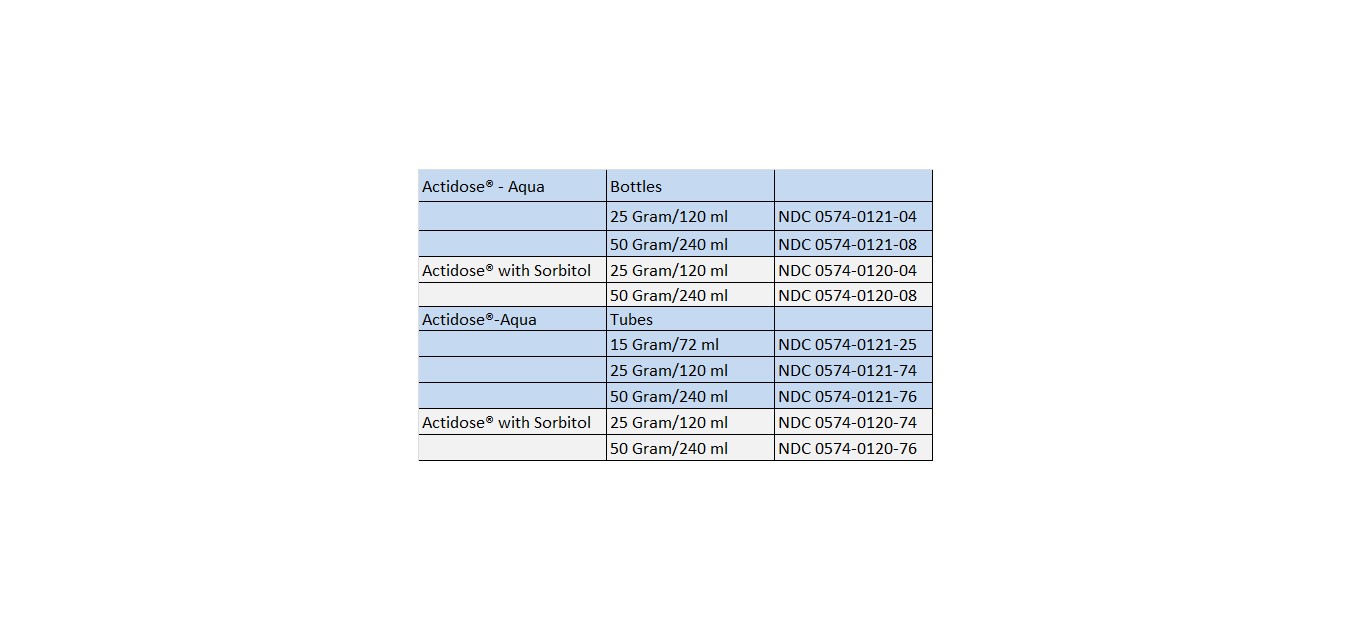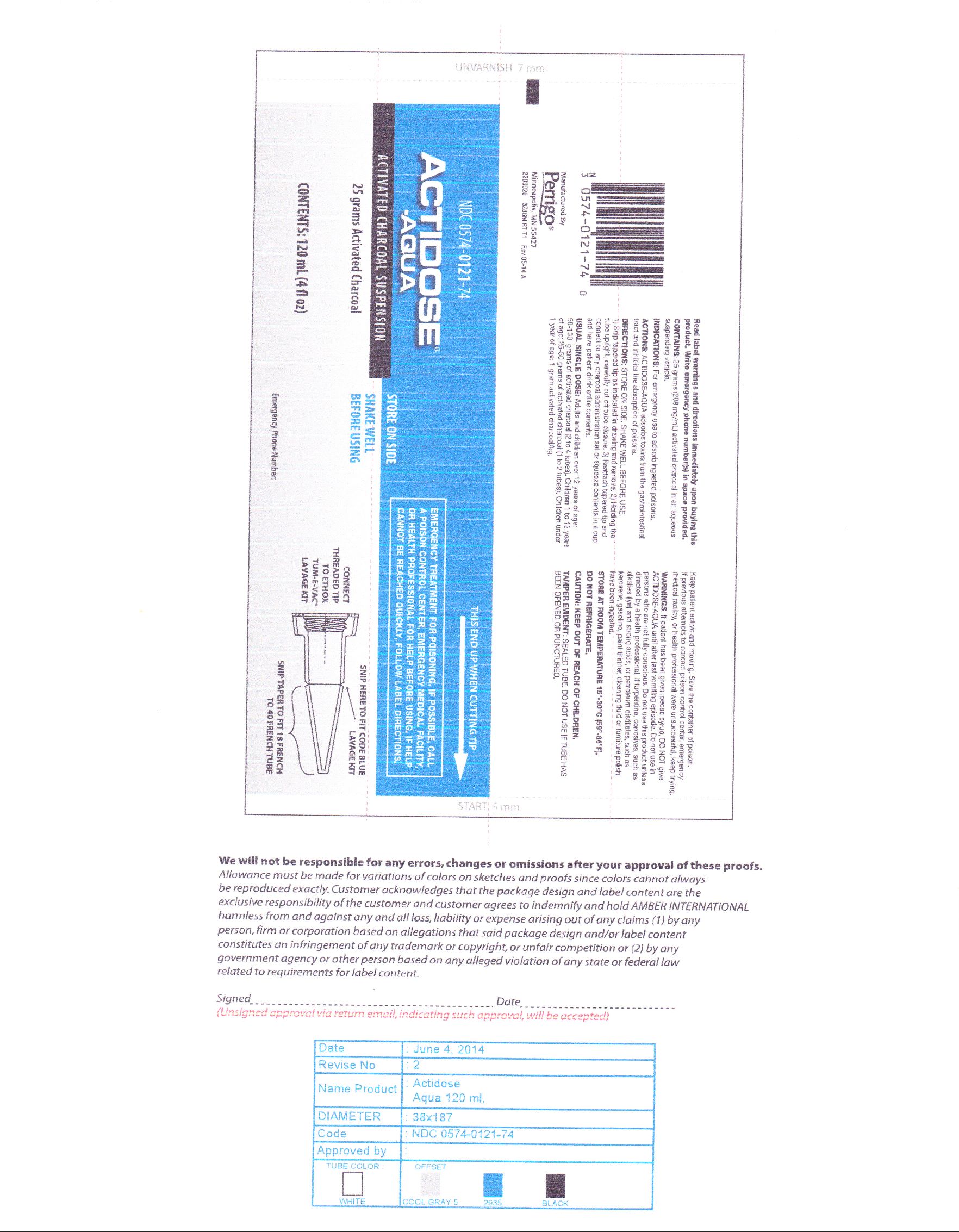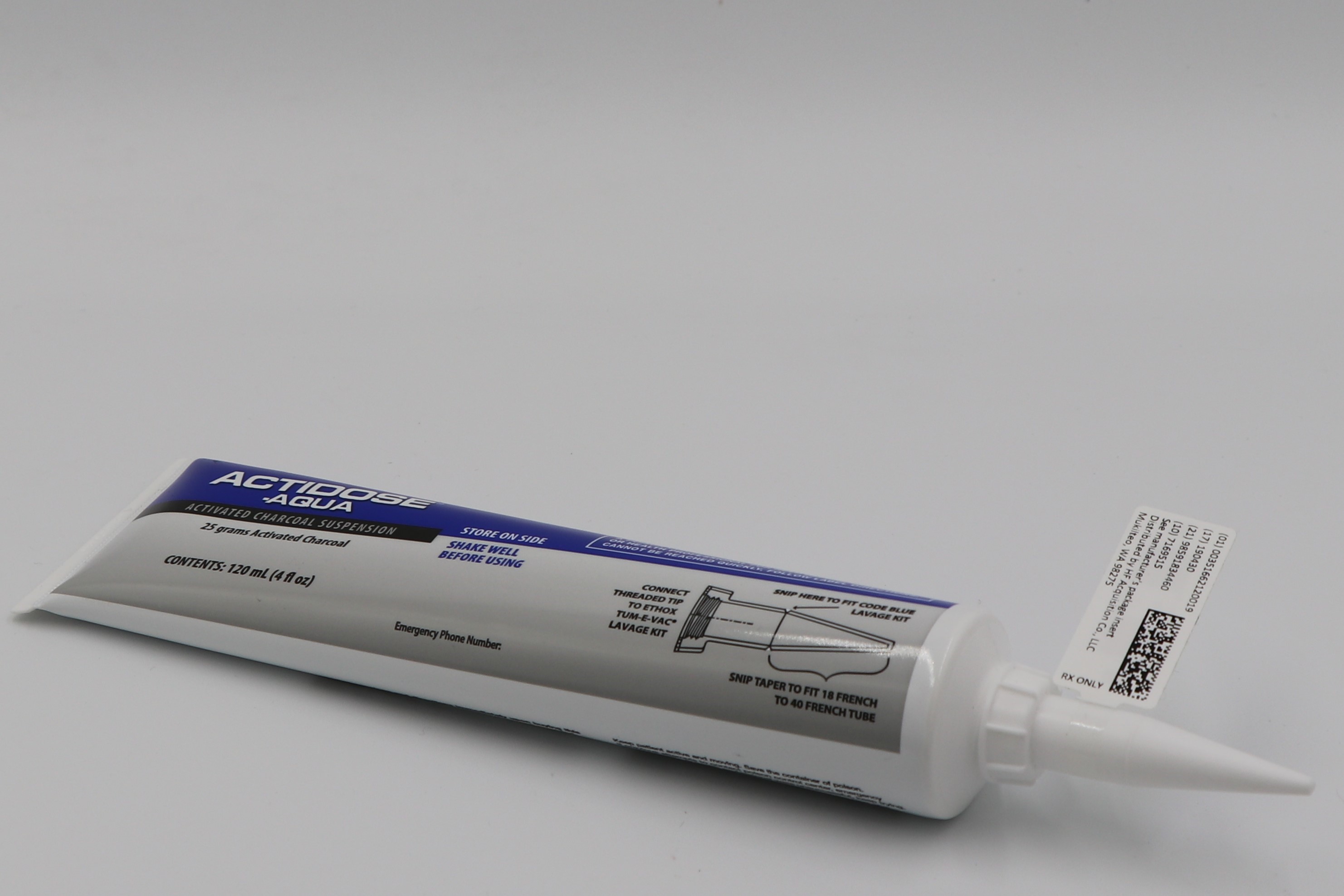ACTIVATED CHARCOAL suspension
ACTIVATED CHARCOAL by
Drug Labeling and Warnings
ACTIVATED CHARCOAL by is a Prescription medication manufactured, distributed, or labeled by HF Acquisition Co LLC, DBA HealthFirst. Drug facts, warnings, and ingredients follow.
Drug Details [pdf]
- SPL UNCLASSIFIED
-
DESCRIPTION
Actidose® with Sorbitol: Actidose® with Sorbitol, ready-to-use activated charcoal suspension with sorbitol, contains 25 gm or 50 gm of activated charcoal, and 48 gm or 96 gm of sorbitol, respectively, in an aqueous suspension with a unique preservative system. Each milliliter contains 208 mg (0.208 gm) of activated charcoal and 400 mg (0.400 gm) of sorbitol. Sorbitol reduces the gritty sensation associated with activated charcoal, imparts a sweet taste which enhances patient compliance, and usually produces a cathartic effect.
Actidose®-Aqua: Actidose®-Aqua, ready-to-use activated charcoal suspension, contains 15 gm, 25 gm or 50 gm of activated charcoal in an aqueous suspension with a unique preservative system. Each milliliter contains 208 mg (0.208 gm) of activated charcoal.
-
WARNINGS
If patient has been given ipecac syrup, DO NOT give ACTIDOSE® WITH SORBITOL or ACTIDOSE®-AQUA until after last vomiting episode. Do not use in persons who are not fully conscious. Do not use this product unless directed by a health professional, if turpentine, corrosives, such as alkalies (lye) and strong acids, or petroleum distillates, such as kerosene, gasoline, paint thinner, cleaning fluid or furniture polish, have been ingested. This product is not recommended for use in children weighing less than 32 kg, or during multiple dose activated charcoal therapy since excessive catharsis and significant fluid and electrolyte abnormalities may occur.
Keep this and all drugs out of the reach of children.
Do not use Actidose® with Sorbitol or Actidose®-Aqua in any person known to have a rare autosomal recessive genetic intolerance to fructose. Do not use Actidose® with Sorbitol in patients who are dehydrated. Actidose® with Sorbitol may cause excessive diarrhea.
-
CLINICAL PHARMACOLOGY
Activated Charcoal:
Activated charcoal is produced by pyrolysis of organic material, such as wood, and an activation process which cleanses and fragments the charcoal by exposure to an oxidizing gas compound of steam, oxygen, and acids at high temperatures resulting in increased surface area through the creation of numerous external and internal pores. These pores serve as reservoirs to adsorb substances admixed with activated charcoal, making it a useful adsorbent for specified toxins.
Activated charcoal is pharmacologically inert and is not absorbed in the gastrointestinal tract. Activated charcoal will adsorb a variety of organic and inorganic substances, but is especially effective in adsorbing compounds within a molecular weight range of 100 to 1,000 Daltons (AMU’s).1 Several other physiologic and physicochemical factors influence the adsorptive capacity of activated charcoal including: pH, charcoal: drug ratio, gastric contents, and adsorption kinetics.2
Much of the published scientific literature which studied the adsorptive capacity of activated charcoal was conducted using in vitro models. A considerable amount of the research may be invalid since the effects of physiologic pH were not taken into consideration or held constant. Using research models which simulate the gastric environment, some toxins were not adsorbed by activated charcoal. This data was inappropriately extended to imply that activated charcoal did not adsorb a toxin and therefore had no efficacy in the management of that type of poisoning incident. However, the research failed to consider that the increased pH of the small intestine provides a receptive environment for the adsorption of the toxin by activated charcoal. Activated charcoal will effectively adsorb acidic, alkaline and neutral substances (not to suggest use of activated charcoal in poisonings caused by corrosive agents2). The extent of adsorption will be dependent upon the relative solubility of the drug at a specified pH.
The optimal dosage ratio of activated charcoal to toxin is described as 10:1.3,4,17,18 Numerous factors contribute to and interfere with adsorptive capacity, therefore, the 10:1 ratio may not be valid in the clinical setting. Furthermore, a primary application of activated charcoal is in adult patients who have intentionally ingested a toxin for drug abuse or suicidal purposes. These patients may not freely provide information about the substance or amount ingested, or have a decreased level of consciousness. Under these conditions it is difficult to determine the ingestion history, making it impractical to use the 10:1 ratio. The 10:1 ratio is also impractical when large amounts of toxin have been ingested (i.e., an overdose of 50 gm of aspirin would then require 500 gm [1.1 lbs.] of activated charcoal).
Gastric contents may also compete with ingested toxins and compromise the adsorption of the toxins by activated charcoal.2 If activated charcoal is to be administered to a patient known to have ingested a large meal in close proximity to the time of treatment, a larger dose of activated charcoal may be appropriate.
Under appropriate physiologic conditions activated charcoal adsorbs toxins instantaneously. This adsorptive process is reversible and an equilibrium between free and bound toxin will exist. According to the law of mass action the amount of free drug decreases as the dose of activated charcoal increases. Therefore, large doses of activated charcoal can favor the equilibrium toward greater toxin adsorption and efficacy. There is limited evidence that desorption of a toxin from activated charcoal may occur.19 Therefore, there is a potential for toxin readsorption and enhanced toxicity. The current standard of care is to administer a cathartic with single doses of activated charcoal to hasten the elimination of the toxin/activated charcoal complex from the gastrointestinal tract.5 Cathartics should be used with extreme care during multiple dose activated charcoal therapy and it is not recommended to use a cathartic with each dose of activated charcoal.5
Sorbitol:
Sorbitol is a hexahydric sugar alcohol which primarily serves as an osmotic cathartic in Actidose® with Sorbitol.6 A secondary advantage of using sorbitol is as a palatability enhancer to decrease the innate gritty texture of activated charcoal and to provide a sweet vehicle to increase patient compliance. Sorbitol is poorly absorbed during its transit through the gastrointestinal tract. Absorbed sorbitol is metabolized by the liver and slowly converted to fructose. Insulin is not necessary for intracellular transport of sorbitol, therefore customary cathartic doses can be safely used by patients with diabetes mellitus.
As a hyperosmotic cathartic sorbitol produces a hygroscopic action resulting in increased water in the large intestine and increased intraluminal pressure which stimulates catharsis. Studies have been conducted in healthy adult human volunteers using therapeutic amounts of activated charcoal and sorbitol.8,9 Catharsis of activated charcoal occurred in an average of 1.0 - 1.5 hours and persisted for 8 - 12 hours. Fourteen poisoned patients are reported in one series representing a wide range of toxins and dosages of sorbitol resulting in the onset of catharsis in an average of 7.7 hours.10 The onset of action may be expected to be longer in patients who have ingested toxins which decrease bowel motility, such as pharmacological agents and plants with anticholinergic properties, and drugs like narcotics.20
Sorbitol does not compromise the adsorptive capacity of activated charcoal.11, 12
-
INDICATIONS & USAGE
Actidose® with Sorbitol and Actidose®-Aqua should be used in a supervised medical facility or under the direction of a physician or poison control center.
Actidose® with Sorbitol and Actidose®-Aqua are indicated in the management of many types of poisoning emergencies when a toxin has been ingested or when indicated for a limited number of systemic poisonings resulting from parenteral overdosage or when the toxin has been totally absorbed. If physiologic conditions are optimal, activated charcoal most effectively adsorbs toxins with a molecular weight of 100 - 1,000 Daltons (AMU’s).1 Activated charcoal may not be as effective in adsorbing low molecular weight substances such as aliphatic alcohols (methanol, isopropanol, ethanol, etc.) metals (iron, lead, mercury, etc.) and elements such as lithium.2. Two animal studies have demonstrated that very toxic and low molecular weight cyanide compounds are adsorbed by activated charcoal.21,22 The use of activated charcoal in toxic emergencies involving these substances is not contraindicated. Many poisonings involve multiple substances, therefore, Actidose® with Sorbitol and Actidose®-Aqua may be effective in adsorbing some or all of the ingested toxins.
Adsorption of a toxin by activated charcoal can occur anywhere in the gastrointestinal tract. However, to use Actidose® with Sorbitol or Actidose®-Aqua most effectively it is important to administer it as soon as possible to the victim of an ingested exposure. The longer the delay between the ingestion of the toxin and administration of activated charcoal, the less effective it will be. If syrup of ipecac is being used to produce emesis, administration of Actidose® with Sorbitol or Actidose®-Aqua is customarily delayed until 30 – 60 minutes after conclusion of emesis. In a study which used syrup of ipecac, 60 ml, activated charcoal did not interfere with the emetic effect of syrup of ipecac.23
If gastric lavage is being used to facilitate stomach evacuation a single dose of activated charcoal can be administered in the early stages of gastric lavage. If this technique is utilized, Actidose®-Aqua, which does not contain sorbitol, should be used. Upon completion of gastric lavage Actidose® with Sorbitol can be instilled via the lavage tube. The only disadvantage to the use of activated charcoal in this fashion is that the gastric lavage returns will be black, thus making it difficult to evaluate what the patient ingested by visual examination. The primary advantage of this therapy is that activated charcoal can be administered early to the patient. The convenient packaging of Actidose® with Sorbitol and Actidose®-Aqua (except the 15gm/72ml size) in a squeeze bottle with a tapered nozzle expedites emergency treatment, allowing attachment to a gastric lavage tube and administration of contents.
The most common application of activated charcoal is in acute toxic exposures where Actidose® with Sorbitol and Actidose®-Aqua can adsorb toxins thereby preventing their absorption. Activated charcoal can also be used in some toxic emergencies when absorption is complete or exposure was via a parenteral route. This application usually involves repetitive or multiple doses of activated charcoal.
Multiple doses of activated charcoal may be useful in adsorbing toxins which undergo enterohepatic circulation.13 Drugs which are subject to biliary secretion such as digitoxin are constantly secreted into the gastrointestinal tract and are reabsorbed resulting in prolonged toxicity. Frequent doses of activated charcoal can adsorb those toxins thereby preventing their reabsorption and enhancing toxin elimination through the gastrointestinal tract.
Multiple dose activated charcoal is also used in what is termed gastrointestinal dialysis.14 There are only a limited number of toxins which may be eliminated by this method. Clinical judgement and the toxin’s pharmacokinetic parameters must be considered to determine the applicability of this treatment which is not universally applicable.24 The toxin passively diffuses along a concentration gradient between blood which is perfusing the gastrointestinal tract and the luminal fluids. The multiple doses of activated charcoal adsorb the toxin thereby preventing its reabsorption further maximizing the concentration gradient which permits diffusion of even more toxin into the gastric lumen. Compounds most effectively transferred by this mechanism are lipophilic, uncharged and not excessively bound to proteins. Phenobarbital and theophylline are examples of toxins which can be eliminated more rapidly by this method.15,16
Actidose® with Sorbitol should not be used in each dose of the multiple dose activated charcoal regimen unless it is necessary to produce catharsis. Actidose® with Sorbitol contains sorbitol which may produce excessive catharsis and resultant fluid and electrolyte problems if used at each dosing interval (see Precautions).9,25 Actidose®-Aqua should be used at dosage intervals when Actidose® with Sorbitol is not being used. CATHARTICS SHOULD BE USED CAUTIOUSLY AND ONLY INTERMITTENTLY DURING MULTIPLE DOSE ACTIVATED CHARCOAL THERAPY.
If catharsis of activated charcoal does not occur following the use of Actidose® with Sorbitol within 4 - 8 hours, an additional sorbitol dose of 1.5 gm/kg may be administered. Or, if desired, a saline cathartic such as magnesium citrate may be used if the patient’s renal function is not impaired. Actidose® with Sorbitol and Actidose®-Aqua are formulated in palatable vehicles which eliminate the need to add additional taste or consistency enhancers. The use of supplementary chemicals, syrups, or dairy products should be avoided since their addition may compromise the adsorptive capacity of Actidose® with Sorbitol and Actidose®-Aqua.
-
CONTRAINDICATIONS
There are no known absolute contraindications to the use of activated charcoal, however, it is not an equally effective adsorbent for all toxins. It should be used with caution, if at all, in patients who have ingested corrosive agents since the activated charcoal may obscure endoscopic visualization of esophageal and gastric lesions produced by the corrosive. The use of a cathartic with activated charcoal may not be advised if a patient has significant fluid or electrolyte abnormalities. Actidose® with Sorbitol should not be used in infants due to the possibility of excessive catharsis. Young children should not receive cathartic doses of sorbitol unless hospitalized and under the immediate care of a physician.
- USE IN CHILDREN
- USE IN PREGNANCY OR DURING LACTATION
-
PRECAUTIONS
Actidose® with Sorbitol and Actidose®-Aqua should be used in a supervised medical facility or under the direction of a physician or poison control center.
Actidose® with Sorbitol and Actidose®-Aqua are adjuncts in the management of poisoning emergencies. Prior to the use of activated charcoal, proper basic life support measures must be implemented as well as the appropriate gastric emptying technique if indicated.
When Actidose® with Sorbitol or Actidose®-Aqua are used to treat a poisoning emergency, the patient and health care providers should be aware that activated charcoal will produce black stools. These stools may be diarrhetic and may persist for several hours.
Actidose® with Sorbitol may produce a profound cathartic effect and proper attention should be given to the patient’s fluid and electrolyte needs. Actidose® with Sorbitol should be used cautiously in patients receiving multiple dose activated charcoal. If Actidose® with Sorbitol is used at each dosage interval, profound catharsis may develop which could result in dehydration, hypotension and significant electrolyte and fluid abnormalities.
A study conducted in healthy adult human volunteers who ingested therapeutic amounts of activated charcoal and sorbitol resulted in severe prolonged diarrhea, but no significant changes were noted in serum electrolytes or osmolality, BUN, or the metabolic profile as compared to the control.8
Gastrointestinal obstruction from activated charcoal may occur as a consequence of toxin-induced antiperistaltic effects. Actidose® with Sorbitol and Actidose®-Aqua should be used cautiously in patients who have been exposed to toxins which interfere with gastrointestinal tract peristalsis (i.e., anticholinergics, opioids, etc.). Bowel sounds should be frequently monitored to assess peristaltic action, especially in patients undergoing multiple dose activated charcoal therapy.
-
ADVERSE REACTIONS
Activated charcoal with sorbitol has produced severe hypernatremic dehydration when used in excessive amounts in pediatric patients.25, 27
Aspiration of activated charcoal has been reported to produce airway obstruction and a limited number of fatalities have occurred. 28,29,30,31 Bronchiolitis obliterans resulting in death has developed several weeks after the aspiration of activated charcoal.32
Gastrointestinal obstruction associated with the use of multiple dose activated charcoal therapy has been reported.33 An overdose of carbamazepine was responsible for the antiperistaltic effects which led to bowel obstruction.
-
DOSAGE & ADMINISTRATION
Prior to administration of Actidose® with Sorbitol or Actidose®-Aqua, shake the container thoroughly for a minimum of 30 seconds. After administration of either Actidose® with Sorbitol or Actidose®-Aqua, the container should be thoroughly rinsed with water and any residue should be administered to the patient to ensure that the entire dose has been delivered.
Single Dose - Actidose®-Aqua
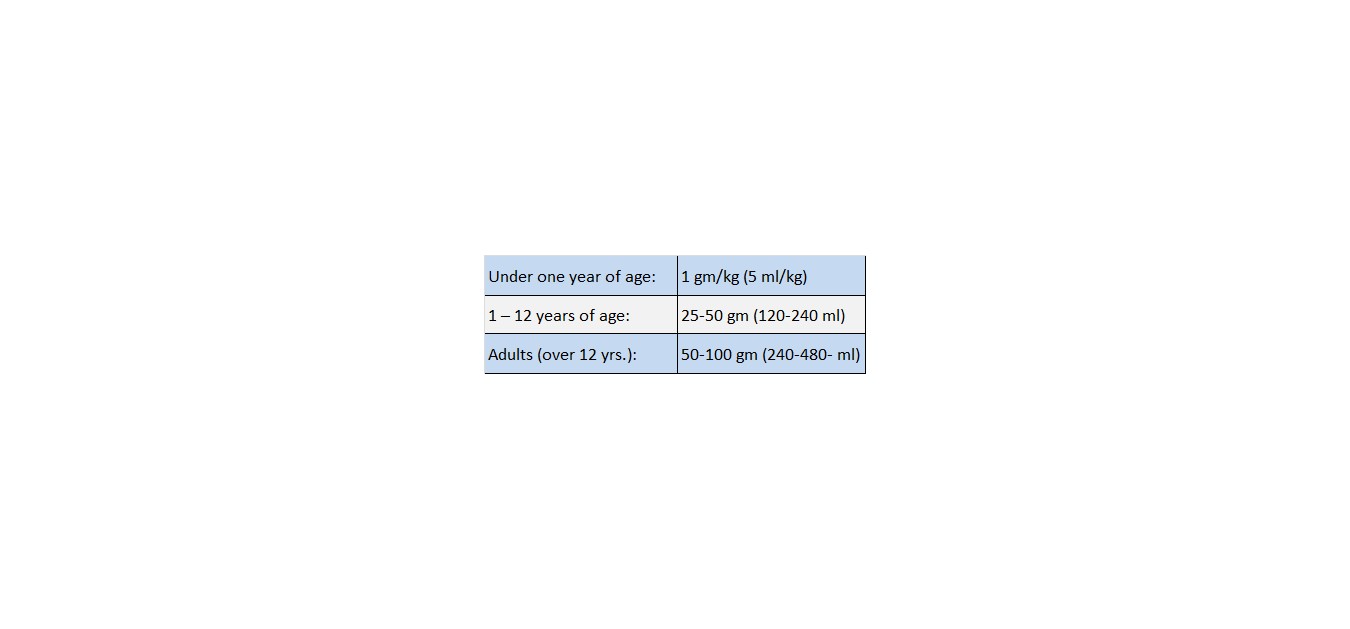
Single Dose - Actidose® with Sorbitol
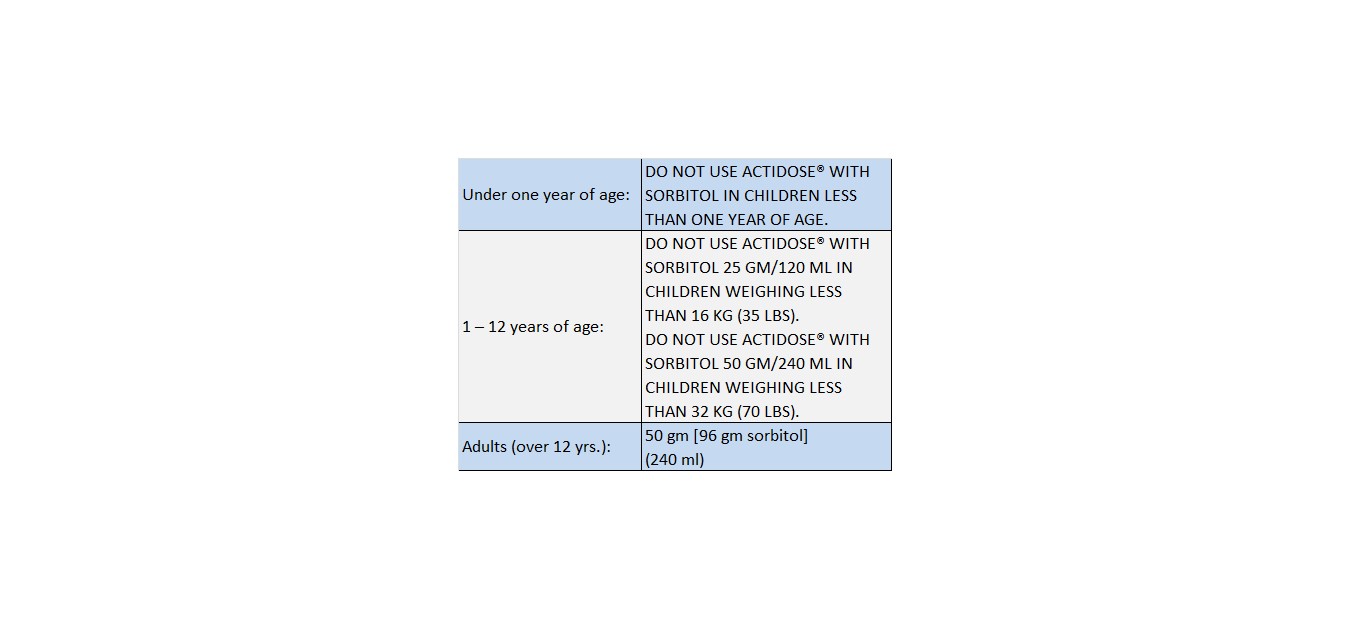
Multiple Dose - Actidose®-Aqua
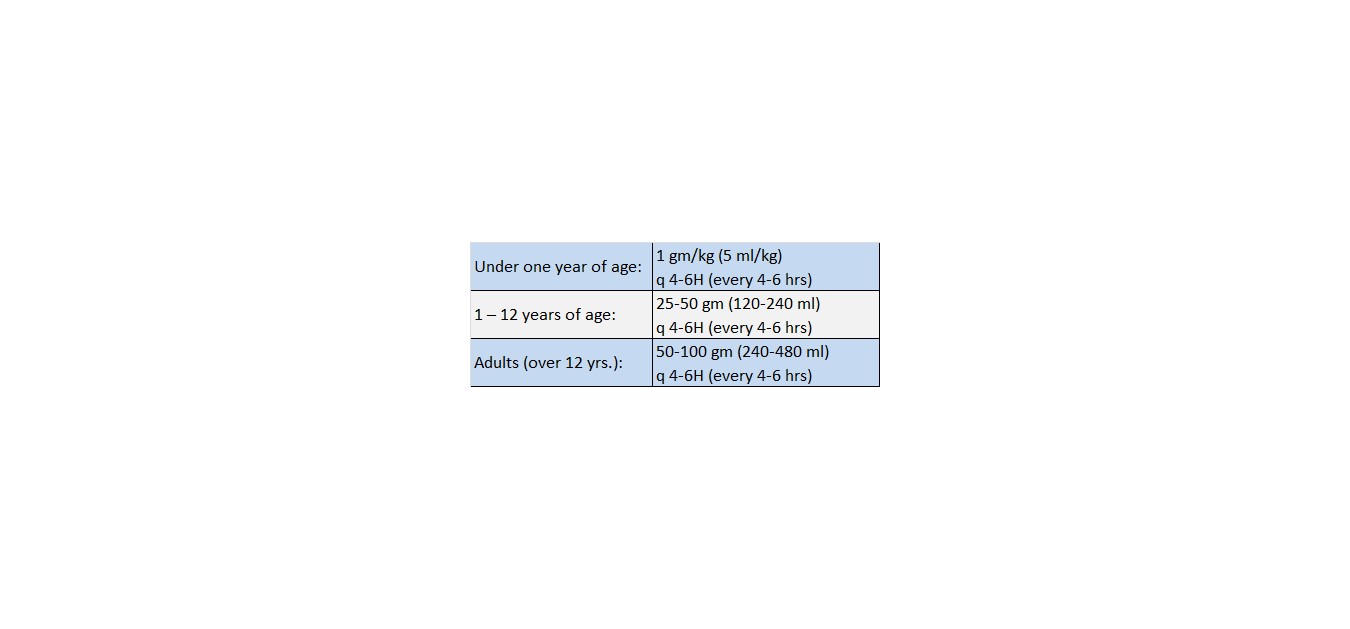
Multiple Dose - Actidose® with Sorbitol
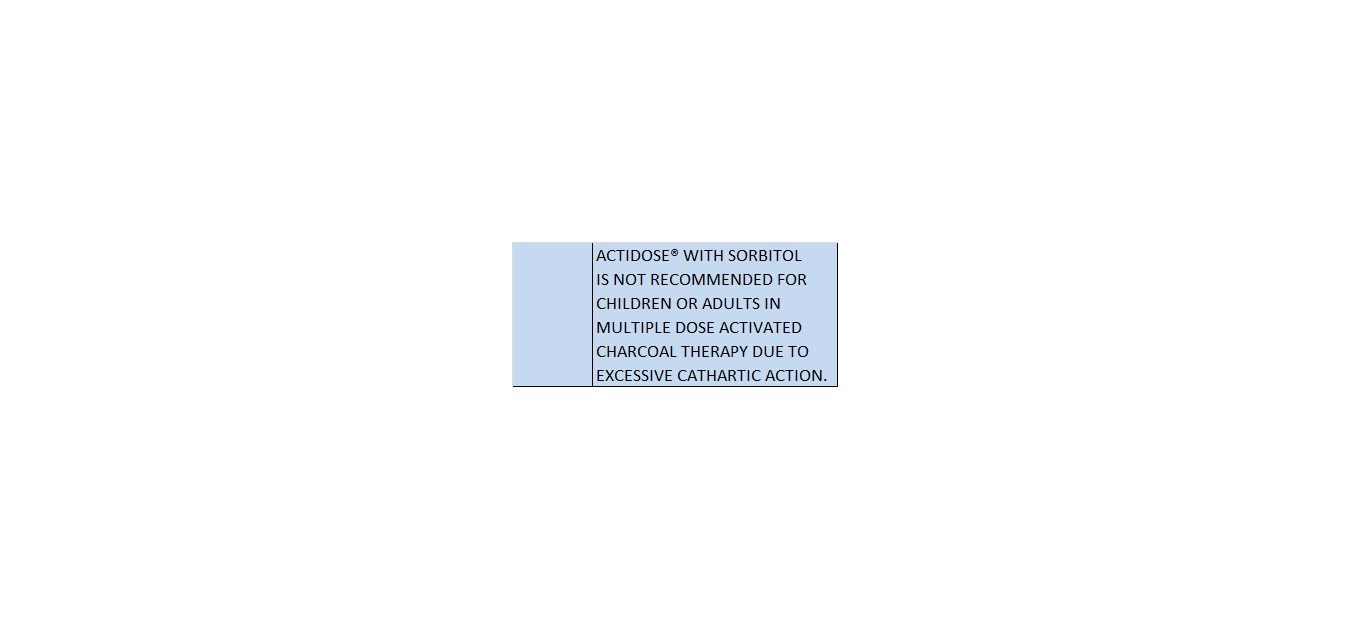
- HOW SUPPLIED
-
REFERENCES
1.
Activated Charcoal, Antidotal and Other Medicinal Uses, Marcel Dekker, New York, 1980.
2.
Clinical Pharmacokinetics. 1982; 7: 465-489.
3.
Handbook of Common Poisonings in Children, American Academy of Pediatrics, Evanston, 1983.
4.
Am J Emerg Med. 1985; 3: 280-283.
5.
Poisindex Information System, Micromedix, Denver, 1991.
6.
J Pediatrics. 1981; 98: 157-158.
7.
Diabetes Care. 1978; 1: 223-230.
8.
Clinical Toxicology. 1985; 22: 529-536.
9.
Ann. Emerg . Med. 1985; 14: 1152-1155.
10.
Clinical Toxicology. 1985; 23: 579-587.
11.
J. Pharmacol . Exp. Ther . 1982; 221: 656-663.
12.
Am. J. Hosp. Pharm. 1978, 35: 1355-1359.
13.
Lancet. 1981; 2: 1177-1178.
14.
NEJM. 1982; 307: 676-678.
15.
NEJM. 1982; 307: 642-644.
16.
Clin . Pharmacol . Therap. 1983; 34: 663-666.
17.
Medical Toxicology. New York, Elsevier, 1988.
18.
Clinical Management of Poisoning and Drug Overdose. Philadelphia, W.B. Saunders Co., 1990.
19.
Arch Intern Med. 1987; 147: 1390-1392.
20.
Clin Toxicol . 1989; 27: 91-99.
21.
Ann Emerg Med. 1988; 17: 595-598.
22.
Ann Emerg Med. 1990; 19: 453.
23.
Ann Emerg Med. 1987; 16: 164-166.
24.
Ann Emerg Med. 1991; 20: 529-531.
25.
J. Pediatrics. 1986; 109: 719-722.
26.
Ann Emerg Med. 1986; 15: 1214-1218.
27.
J. Pediatrics. 1988; 112: 333.
28.
Vet Hum Toxicol . 1989; 31: 335.
29.
B Med J. 1988; 297: 459-460.
30.
NCMJ. 1990; 51: 79-80.
31.
Ann Emerg Med. 1981; 10: 528-529.
32.
Chest. 1989; 96: 672-674.
33.
J Emerg Med. 1986; 4: 401-407. - SPL UNCLASSIFIED
- PRINCIPAL DISPLAY PANEL-TUBE LABEL
- PRINCIPAL DISPLAY PANEL-SERIALIZED TUBE LABELING
-
INGREDIENTS AND APPEARANCE
ACTIVATED CHARCOAL
activated charcoal suspensionProduct Information Product Type HUMAN PRESCRIPTION DRUG Item Code (Source) NDC: 51662-1200(NDC:0574-0121) Route of Administration ORAL Active Ingredient/Active Moiety Ingredient Name Basis of Strength Strength ACTIVATED CHARCOAL (UNII: 2P3VWU3H10) (ACTIVATED CHARCOAL - UNII:2P3VWU3H10) ACTIVATED CHARCOAL 208 mg in 1 mL Inactive Ingredients Ingredient Name Strength WATER (UNII: 059QF0KO0R) ANHYDROUS CITRIC ACID (UNII: XF417D3PSL) SUCROSE (UNII: C151H8M554) PROPYLENE GLYCOL (UNII: 6DC9Q167V3) GLYCERIN (UNII: PDC6A3C0OX) Product Characteristics Color black Score Shape Size Flavor Imprint Code Contains Packaging # Item Code Package Description Marketing Start Date Marketing End Date 1 NDC: 51662-1200-1 129 mL in 1 TUBE; Type 0: Not a Combination Product 12/22/2018 Marketing Information Marketing Category Application Number or Monograph Citation Marketing Start Date Marketing End Date unapproved drug other 12/22/2018 Labeler - HF Acquisition Co LLC, DBA HealthFirst (045657305) Registrant - HF Acquisition Co LLC, DBA HealthFirst (045657305) Establishment Name Address ID/FEI Business Operations HF Acquisition Co LLC, DBA HealthFirst 045657305 relabel(51662-1200)
© 2025 FDA.report
This site is not affiliated with or endorsed by the FDA.
